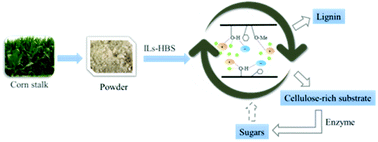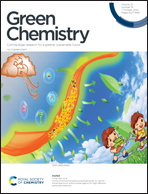A renewable co-solvent promoting the selective removal of lignin by increasing the total number of hydrogen bonds †
Abstract
Due to their low cost and excellent solubility, functional ionic liquids (ILs) have been widely used in the pretreatment of lignocellulose. However, the high viscosity and harsh pretreatment conditions of ILs usually bring difficulties in separation and regeneration, hindering the large-scale use of ILs for industrial applications. To solve these problems, four sugar-platform renewable high boiling alcohol solvents (HBS) that can form hydrogen bonds with lignin were chosen as co-solvents. This confirmed that HBS not only have an effect on the interaction of ILs and lignin, but they also participate in the interaction of the co-solvent and lignin. The cation–anion interaction energy in 2-hydroxy-N-(2-hydroxyethyl)-N-methylethanaminium methanesulfonate ([BHEM]mesy) is weakened, but for hydrogen bond interactions, like IL-lignin and co-solvent-lignin, the energy is increased, as shown by a series of characterization and analysis studies. The system has advantages, like mild reaction conditions, low cost, renewability, high biomass pretreatment efficiency, and excellent cycling performance, which can increase the lignin removal ratio to 95.2%. The recycling and reusability were also evaluated and, after seven rounds, there was no significant reduction in activity. This work provides a promising large-scale sustainable biomass pretreatment strategy for biorefinery processes.

- This article is part of the themed collection: 2020 Green Chemistry Hot Articles


 Please wait while we load your content...
Please wait while we load your content...